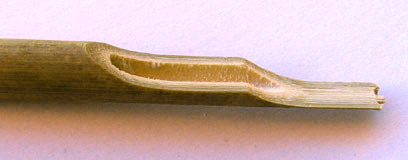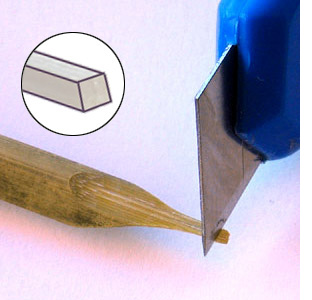Cutting a reed pen following Matthias Gröschke
 A reed pen is very suitable for speedy writing and creative scripts. It can easily be used on very rough paper surfaces.
Bamboo, the raw material, can be found in most DIY superstores and market gardens. The available qualities are very different. If the bamboo is too soft, it's not suitable for a reed pen.
You have to try it out.
A reed pen is very suitable for speedy writing and creative scripts. It can easily be used on very rough paper surfaces.
Bamboo, the raw material, can be found in most DIY superstores and market gardens. The available qualities are very different. If the bamboo is too soft, it's not suitable for a reed pen.
You have to try it out.
The reed pen has to be dipped into the inkwell more often than common metal nibs, but the stroke is much livelier.
For the cutting of a reed pen you need a very keen knife or cutter. Work with the appropriate caution!
Working according to these instructions is at your own risk!
Cut a bamboo stick of about 15 to 20cm. The stick is then cut to half its thickness over a length of about 3 cm.

Continue cutting until you have a flat surface at the front with a length of about 1.5 to 2cm.

Turn the bamboo stick and remove some material from the top, parallel to the 2nd cut, until the thickness of the front edge is about 0.5mm. A thinner edge will break when pressure is applied, if it's too thick, it has no flexibility.

Put the bamboo stick on a stiff wooden bark - bottom side up - and press the point of your knife into the bamboo stick, approx. 1.5cm away from front edge, until the front part splits in two. Should this not work, either the front edge is too thick or the bamboo is too soft. Try different qualities to find out the best for this purpose.

As required the writing edge can be cut broader or narrower or entirely pointed. Take away material from both sides, always leaving the split in the middle. 
Put the bamboo stick on a stiff wooden bark again and cut the tip to receive a sharp writing edge. Ready for writing! After a while the tip softens and has to be cut again.

▪ This instruction is available as a leaflet in the calligraphy shop.
▪ Information about the cutting of goose quills can be found in the Online Pen Nibs Museum. At the moment only in German language.